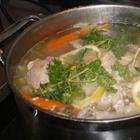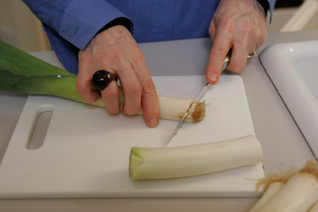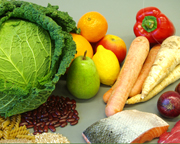 |
Nutrition for Overall Health
Powerful Patient, 2009 Week 4
Host: Joyce Graff, http://powerfulpatient.org, editor@vhl.org 800-767-4845
Beginning January 19, 2008
Joyce Graff speaks with Tina, a nutritionist who has been working with people with complex medical conditions for 27 years, and who is dealing with a rare disease herself. Tina shares her tips for sustaining your stamina no matter what happens.
About Our Guest
Tina is a nutritionist and a diabetes educator. In order to preserve her privacy we are not using her last name. She has von Hippel-Lindau disease (VHL) and is grappling with a number of health issues herself. Her personal challenge, and the challenge all her patients face, is how to maintain her core strength, stamina, and optimistic spirit in the face of the very real physical challenges. Essential elements in maintaining that strength and optimism are good food, good rest, exercise, and gratitude.
How to Clean a Leek
Tina talks about making leek soup, and learning on the internet how to clean a leek. Here are the instructions she referred to:
http://www.ehow.com/how_4544880_clean-leek.html
http://homecooking.about.com/od/howtocookvegetables/a/leekcleaning.htm
Recipes
Here are a few recipes for quick, nutritious soups that combine cooked vegetables with the water in which they are cooked in order to preserve all the vitamins in the vegetables.
 Homemade Chicken Soup Homemade Chicken Soup
From Jill,
http://allrecipes.com/recipe/homemade-chicken-soup/detail.aspx
"Homemade chicken soup - but you don't have to be sick to deserve or enjoy it - you do, so do! Good for body and soul!"
INGREDIENTS
- 1 (3 pound) whole chicken
- 4 carrots, halved
- 4 stalks celery, halved
- 1 large onion, halved
- water to cover
- salt and pepper to taste
- 1 teaspoon chicken bouillon granules (optional)
- Put the chicken, carrots, celery and onion in a large soup pot and cover with cold water. Heat and simmer, uncovered, until the chicken meat falls off of the bones (skim off foam every so often).
- Take everything out of the pot. Strain the broth. Pick the meat off of the bones and chop the carrots, celery and onion. Season the broth with salt, pepper and chicken bouillon to taste, if desired. Return the chicken, carrots, celery and onion to the pot, stir together, and serve.
Basic Vegetable Soup
From Mireille Guiliano --
http://www.mireilleguiliano.com/recipesnew.htm
Basic Vegetable Soup
Serves 8
My mother cooked all the vegetables in water. Although potatoes were always included, the choice of other vegetables was often a matter of availability. The trick was the finish. Here it is: 
2 potatoes (about 4 ounces each)
1 small cabbage
2 leeks
2 carrots
2 celery ribs with their leaves
2 medium-size yellow onions
Freshly ground pepper
2 teaspoons salt
½ teaspoon dried thyme
2 bay leaves
Small bunch of fresh parsley
10 cups of water
1. Peel the vegetables. Cut the potatoes and cabbage into small cubes; wash the leeks carefully and slice them crosswise. Slice the carrots and celery as well, and quarter the onions. You should have about 10 cups of prepared vegetables. Use the same amount of water.
2. Place all the vegetables in a stockpot. Season with a grind of fresh pepper, add the salt, thyme, bay leaves, and parsley, and toss with the vegetables. Add the water. Cover and bring to boil slowly. Reduce the heat and simmer for 1½ hours.
3. Remove and discard the bay leaves. Drain the vegetables, reserving the cooking liquid. Purée the vegetables in a food mill using the cooking liquid over the purée to thin them out. Reheat the soup until the first boil. Taste and correct the seasonings and serve.
At the end of the fall, Mother would add the last tomatoes of the garden and in the dead of winter half of a celery root, but you can add whatever you like. Same for herbs -- suit your fancy.
About VHL
Von Hippel-Lindau is a familial cancer syndrome – a tiny little misspelling in one gene, as if there were one word misspelled in a chapter in a book. People who carry this flaw in their genome are at increased risk for tumors of the retina, brain, spinal cord, kidneys, pancreas, and adrenal glands.
There is no cure for VHL, and treatment is usually surgery to control tumors, keeping them from growing into more serious problems. Over the past fifteen years, this Alliance of physicians and patients has developed strategies for screening, that is proactively checking for issues that might arise, hoping to find them early. Early detection allows the patient and the health care team time to develop a strategy for dealing with the issue as constructively as possible, preserving organ function and avoiding the worst consequence of cancer.
http://vhl.org
http://vhl.inspire.com
|


 Homemade Chicken Soup
Homemade Chicken Soup